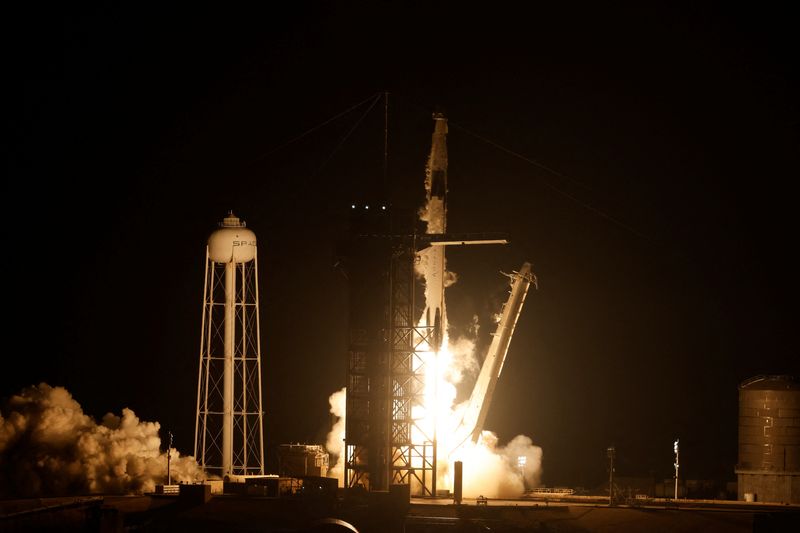By Steve Gorman
LOS ANGELES (Reuters) - Two U.S. astronauts, a Russian cosmonaut and a United Arab Emirates astronaut were safely on their way to the International Space Station (ISS) on Thursday, as their SpaceX ship neared a planned rendezvous with the orbiting laboratory, NASA said.
The autonomously flying SpaceX Crew Dragon capsule was due to reach the space station and dock to the platform shortly after 1:15 a.m. EST (0615 GMT) on Friday, nearly 25 hours after launching from NASA's Kennedy Space Center in Cape Canaveral, Florida.
Control over the spacecraft will be handed off from SpaceX mission control near Los Angeles to NASA's Johnson Space Center in Houston once the Crew Dragon is ready to dock with the ISS.
The four-man team is expected to spend six months aboard the ISS conducting more than 200 experiments and technology demonstrations, ranging from research on human cell growth in space to controlling combustible materials in microgravity.
Some of the research will help pave the way for future long-duration human expeditions to the Moon and beyond under NASA's Artemis program, its successor to Apollo, the U.S. space agency said.
The mission, designated Crew 6, is the sixth long-duration ISS team SpaceX has flown for NASA since the private rocket venture founded by billionaire Elon Musk began sending American astronauts to orbit in May 2020. Musk is CEO of electric car maker Tesla and social media platform Twitter.
SUBMARINER AND ENGINEERS
The latest crew was led by Stephen Bowen, 59, a onetime U.S. Navy submarine officer who has logged more than 40 days in orbit as a veteran of three Space Shuttle flights and seven spacewalks. Fellow NASA astronaut Warren "Woody" Hoburg, 37, an electrical engineer, computer science expert and commercial aviator designated, was making his first spaceflight.
The Crew 6 mission also was notable for its inclusion of UAE astronaut Sultan Alneyadi, 41, only the second person from his country to fly to space and the first to launch from U.S. soil as part of a long-duration space station team.
Rounding out the four-man Crew 6 was Russian cosmonaut Andrey Fedyaev, 42, who like Alneyadi is an engineer and spaceflight rookie designated as a mission specialist for the team.
Fedyaev is the second cosmonaut to fly aboard an American spacecraft under a renewed ride-sharing deal signed in July by NASA and the Russian space agency Roscosmos, despite heightened tensions between Washington and Moscow over Russia's invasion of Ukraine.
The Crew 6 team will be welcomed aboard the space station by seven current ISS occupants - three NASA crew members, including commander Nicole Aunapu Mann, the first Native American woman to fly to space, along with three Russians and a Japanese astronaut.
Those seven are expected to end their mission and depart the space station this month. Four will return in the SpaceX Dragon they rode to orbit in October, and three others will ride home in a Russian Soyuz spacecraft flown empty to the ISS last week to replace one that sprang a coolant leak while docked to the station in December.
The Crew 6 launch came 72 hours after an initial liftoff attempt was scrubbed in the final minutes of countdown early on Monday due to an irregular flow of engine-ignition fluid. NASA said the system worked perfectly after a clogged filter was replaced and the lines purged.
The launch ultimately unfolded with hardly a hiccup. But a faulty sensor was also detected on one of 36 switches connected to a dozen grappling hooks used to latch the nose of the crew capsule to the ISS, but there is enough redundancy in that system that no problems with docking or closing the nose cone are anticipated, NASA and SpaceX officials said.

The launch and rendezvous fell exactly on the four-year anniversary of SpaceX's first uncrewed "Demo-1" test flight of a Dragon spacecraft to the ISS and back in 2019.
(This story has been refiled to correct the GMT conversion in paragraph 2)